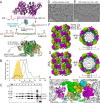This is a preprint.
Active E. coli heteromeric acetyl-CoA carboxylase forms polymorphic helical tubular filaments
- PMID: 38854064
- PMCID: PMC11160672
- DOI: 10.1101/2024.05.28.596234
Active E. coli heteromeric acetyl-CoA carboxylase forms polymorphic helical tubular filaments
Abstract
The Escherichia coli heteromeric acetyl-CoA carboxylase (ACC) has four subunits assumed to form an elusive catalytic complex and are involved in allosteric and transcriptional regulation. The E. coli ACC represents almost all ACCs from pathogenic bacteria making it a key antibiotic development target to fight growing antibiotic resistance. Furthermore, it is a model for cyanobacterial and plant plastid ACCs as biofuel engineering targets. Here we report the catalytic E. coli ACC complex surprisingly forms tubes rather than dispersed particles. The cryo-EM structure reveals key protein-protein interactions underpinning efficient catalysis and how transcriptional regulatory roles are masked during catalysis. Discovering the protein-protein interaction interfaces that facilitate catalysis, allosteric and transcriptional regulation provides new routes to engineering catalytic activity and new targets for drug discovery.
Conflict of interest statement
Competing interests: Authors declare that they have no competing interests.
Figures




Similar articles
-
Chloroflexus aurantiacus acetyl-CoA carboxylase evolves fused biotin carboxylase and biotin carboxyl carrier protein to complete carboxylation activity.mBio. 2024 May 8;15(5):e0341423. doi: 10.1128/mbio.03414-23. Epub 2024 Apr 4. mBio. 2024. PMID: 38572988 Free PMC article.
-
Acetyl-CoA carboxylase from Escherichia coli exhibits a pronounced hysteresis when inhibited by palmitoyl-acyl carrier protein.Arch Biochem Biophys. 2017 Dec 15;636:100-109. doi: 10.1016/j.abb.2017.10.016. Epub 2017 Oct 31. Arch Biochem Biophys. 2017. PMID: 29100983
-
Biotinoyl domain of human acetyl-CoA carboxylase: Structural insights into the carboxyl transfer mechanism.Proteins. 2008 Aug;72(2):613-24. doi: 10.1002/prot.21952. Proteins. 2008. PMID: 18247344
-
Regulation and structure of the heteromeric acetyl-CoA carboxylase.Biochim Biophys Acta. 2016 Sep;1861(9 Pt B):1207-1213. doi: 10.1016/j.bbalip.2016.04.004. Epub 2016 Apr 16. Biochim Biophys Acta. 2016. PMID: 27091637 Review.
-
Multi-subunit acetyl-CoA carboxylases.Prog Lipid Res. 2002 Sep;41(5):407-35. doi: 10.1016/s0163-7827(02)00007-3. Prog Lipid Res. 2002. PMID: 12121720 Review.
References
Publication types
Grants and funding
LinkOut - more resources
Full Text Sources
